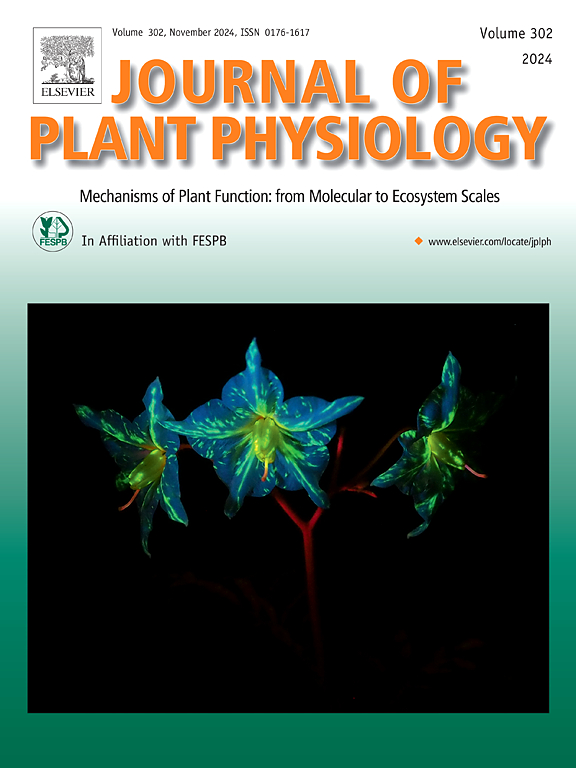Xanthophyll cycle and photosynthetic electron transport enhanced by galactolipid modification alleviate drought-induced leaf senescence
IF 4.1
3区 生物学
Q1 PLANT SCIENCES
引用次数: 0
Abstract
Previous studies have demonstrated galactolipid modification was involved in drought-induced leaf senescence. Under drought stress, overactivation of the photosynthetic electron transfer chain leads to excessive light energy absorption, resulting in photooxidative damage to crops. The xanthophyll cycle, a key photoprotective mechanism, mitigates light-induced damage by dissipating excess energy as heat. However, the role of the xanthophyll cycle pigments and photosynthetic electron transport in the process of galactolipid modification alleviates drought-induced leaf senescence has not yet been clarified clearly. In this study, a comparative experiment was conducted to investigate changes in the xanthophyll cycle and photosynthetic electron transport during drought and re-watering in two maize varieties: a drought-tolerant variety (Liangyu66) and a senescent variety (Liangyu99). Drought stress induced more severely wilted and leaf senescence in Liangyu99, with lower shoot biomass, photosynthetic rate, chlorophyll a/b, monogalactosyldiacylglycerol (MGDG), digalactosyldiacylglycerol (DGDG) content, corresponding gene expression level and DGDG/MGDG ratio compared to Liangyu66. Furthermore, PSII electron transport rate (ETRⅡ), the PSI electron transport rate (ETRⅠ), and cyclic electron flow (CEF) in Liangyu66 were 14 %, 47 %, and 83 % higher, respectively, than in Liangyu99 under drought stress. Notably, the de-epoxidation state of the xanthophyll cycle (A + Z)/(A + Z + V) was significantly higher in Liangyu66 than in Liangyu99. Non-photochemical quenching (NPQ) increased in both varieties under drought stress, Liangyu66 displayed a higher NPQ than Liangyu99. These findings suggest that galactolipid modification alleviates drought-induced leaf senescence by enhancing the xanthophyll cycle and optimizing photosynthetic electron transport.
半乳糖脂修饰增强了叶黄素循环和光合电子传递,减轻了干旱诱导的叶片衰老
以往的研究表明,半乳糖脂修饰与干旱诱导的叶片衰老有关。在干旱胁迫下,光合电子传递链的过度激活导致过度的光能吸收,对作物造成光氧化损伤。叶黄素循环是一种关键的光保护机制,通过将多余的能量转化为热量来减轻光引起的损伤。然而,叶黄素循环色素和光合电子传递在半乳糖脂修饰过程中缓解干旱诱导的叶片衰老的作用尚不清楚。以抗旱玉米品种凉育66和衰老玉米品种凉育99为研究对象,研究了干旱和复水期间玉米叶黄素循环和光合电子传递的变化。干旱胁迫导致凉玉99的萎蔫和叶片衰老更为严重,茎部生物量、光合速率、叶绿素a/b、单半乳糖基二酰基甘油(MGDG)、双半乳糖基二酰基甘油(DGDG)含量、相应基因表达量和DGDG/MGDG比值均低于凉玉66。干旱胁迫下,凉玉66的PSII电子传递率(ETRⅡ)、PSI电子传递率(ETRⅠ)和循环电子流(CEF)分别比凉玉99高14%、47%和83%。值得注意的是,两玉66的叶黄素循环(A + Z)/(A + Z + V)的去环氧化状态显著高于两玉99。干旱胁迫下,两品种的非光化学猝灭(NPQ)均有所增加,其中良玉66的NPQ高于良玉99。这些结果表明,半乳糖脂修饰通过增强叶黄素循环和优化光合电子传递来缓解干旱诱导的叶片衰老。
本文章由计算机程序翻译,如有差异,请以英文原文为准。
求助全文
约1分钟内获得全文
求助全文
来源期刊

Journal of plant physiology
生物-植物科学
CiteScore
7.20
自引率
4.70%
发文量
196
审稿时长
32 days
期刊介绍:
The Journal of Plant Physiology is a broad-spectrum journal that welcomes high-quality submissions in all major areas of plant physiology, including plant biochemistry, functional biotechnology, computational and synthetic plant biology, growth and development, photosynthesis and respiration, transport and translocation, plant-microbe interactions, biotic and abiotic stress. Studies are welcome at all levels of integration ranging from molecules and cells to organisms and their environments and are expected to use state-of-the-art methodologies. Pure gene expression studies are not within the focus of our journal. To be considered for publication, papers must significantly contribute to the mechanistic understanding of physiological processes, and not be merely descriptive, or confirmatory of previous results. We encourage the submission of papers that explore the physiology of non-model as well as accepted model species and those that bridge basic and applied research. For instance, studies on agricultural plants that show new physiological mechanisms to improve agricultural efficiency are welcome. Studies performed under uncontrolled situations (e.g. field conditions) not providing mechanistic insight will not be considered for publication.
The Journal of Plant Physiology publishes several types of articles: Original Research Articles, Reviews, Perspectives Articles, and Short Communications. Reviews and Perspectives will be solicited by the Editors; unsolicited reviews are also welcome but only from authors with a strong track record in the field of the review. Original research papers comprise the majority of published contributions.
 求助内容:
求助内容: 应助结果提醒方式:
应助结果提醒方式:


